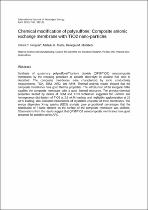 ResearchSpace
ResearchSpace
Chemical modification of polysulfone: composite anionic exchange membrane with TiO2 nano-particles
JavaScript is disabled for your browser. Some features of this site may not work without it.
- ResearchSpace
- →
- Research Publications/Outputs
- →
- Journal Articles
- →
- View Item
| dc.contributor.author |
Nonjola, Patrick NT

|
|
| dc.contributor.author |
Mathe, Mahlanyane K

|
|
| dc.contributor.author |
Modibedi, Remegia M

|
|
| dc.date.accessioned | 2014-02-19T07:47:57Z | |
| dc.date.available | 2014-02-19T07:47:57Z | |
| dc.date.issued | 2013-04 | |
| dc.identifier.citation | Nonjola, P.T, Mathe, M.K and Modibedi, R.M. 2013. Chemical modification of polysulfone: composite anionic exchange membrane with TiO2 nano-particles. International Journal of Hydrogen Energy, vol. 38(12), pp 5115-5121 | en_US |
| dc.identifier.issn | 0360-3199 | |
| dc.identifier.uri | http://ac.els-cdn.com/S0360319913003947/1-s2.0-S0360319913003947-main.pdf?_tid=9f1be398-97dd-11e3-a5f9-00000aacb361&acdnat=1392646566_21f86457984606cca34900ebee54c5ee | |
| dc.identifier.uri | http://hdl.handle.net/10204/7225 | |
| dc.identifier.uri | https://www.sciencedirect.com/science/article/pii/S0360319913003947 | |
| dc.identifier.uri | https://doi.org/10.1016/j.ijhydene.2013.02.028 | |
| dc.description | Copyright: 2013 Elsevier. This is an ABSTRACT ONLY. The definitive version is published in International Journal of Hydrogen Energy, vol. 38(12), pp 5115-5121 | en_US |
| dc.description.abstract | Synthesis of quaternary polysulfone/Titanium dioxide (QPSf/TiO2) nanocomposite membranes by the recasting procedure as suitable electrolyte in alkaline fuel cells is described. The composite membranes were characterized by ionic conductivity measurements, TGA, SEM, XRD, and AFM. Thermal analysis results showed that the composite membranes have good thermal properties. The introduction of the inorganic filler supplies the composite membrane with a good thermal resistance. The physico-chemical properties studied by means of SEM and XRD techniques suggested the uniform and homogeneous distribution of TiO2 at 2.5wt. % loading, and negligible agglomeration at 10wt % loading, also indicated enhancement of crystalline character of these membranes. The energy dispersive X-ray spectra (EDS) analysis gave proportional percentages that the distribution of Titania element on the surface of the composite membrane was uniform. Observations from the results suggest that QPSf/TiO2 nanocomposite membranes have good prospects for possible use in AFC. | en_US |
| dc.language.iso | en | en_US |
| dc.publisher | Elsevier | en_US |
| dc.relation.ispartofseries | Workflow;10376 | |
| dc.subject | Quaternized polysulfone | en_US |
| dc.subject | Composite polymer membranes | en_US |
| dc.subject | Titania | en_US |
| dc.subject | Alkaline membrane fuel cells | en_US |
| dc.subject | Ionic conductivity | en_US |
| dc.title | Chemical modification of polysulfone: composite anionic exchange membrane with TiO2 nano-particles | en_US |
| dc.type | Article | en_US |
| dc.identifier.apacitation | Nonjola, P. N., Mathe, M. K., & Modibedi, R. M. (2013). Chemical modification of polysulfone: composite anionic exchange membrane with TiO2 nano-particles. http://hdl.handle.net/10204/7225 | en_ZA |
| dc.identifier.chicagocitation | Nonjola, Patrick NT, Mahlanyane K Mathe, and Remegia M Modibedi "Chemical modification of polysulfone: composite anionic exchange membrane with TiO2 nano-particles." (2013) http://hdl.handle.net/10204/7225 | en_ZA |
| dc.identifier.vancouvercitation | Nonjola PN, Mathe MK, Modibedi RM. Chemical modification of polysulfone: composite anionic exchange membrane with TiO2 nano-particles. 2013; http://hdl.handle.net/10204/7225. | en_ZA |
| dc.identifier.ris | TY - Article AU - Nonjola, Patrick NT AU - Mathe, Mahlanyane K AU - Modibedi, Remegia M AB - Synthesis of quaternary polysulfone/Titanium dioxide (QPSf/TiO2) nanocomposite membranes by the recasting procedure as suitable electrolyte in alkaline fuel cells is described. The composite membranes were characterized by ionic conductivity measurements, TGA, SEM, XRD, and AFM. Thermal analysis results showed that the composite membranes have good thermal properties. The introduction of the inorganic filler supplies the composite membrane with a good thermal resistance. The physico-chemical properties studied by means of SEM and XRD techniques suggested the uniform and homogeneous distribution of TiO2 at 2.5wt. % loading, and negligible agglomeration at 10wt % loading, also indicated enhancement of crystalline character of these membranes. The energy dispersive X-ray spectra (EDS) analysis gave proportional percentages that the distribution of Titania element on the surface of the composite membrane was uniform. Observations from the results suggest that QPSf/TiO2 nanocomposite membranes have good prospects for possible use in AFC. DA - 2013-04 DB - ResearchSpace DP - CSIR KW - Quaternized polysulfone KW - Composite polymer membranes KW - Titania KW - Alkaline membrane fuel cells KW - Ionic conductivity LK - https://researchspace.csir.co.za PY - 2013 SM - 0360-3199 T1 - Chemical modification of polysulfone: composite anionic exchange membrane with TiO2 nano-particles TI - Chemical modification of polysulfone: composite anionic exchange membrane with TiO2 nano-particles UR - http://hdl.handle.net/10204/7225 ER - | en_ZA |





